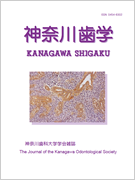- HOME
- > 一般の方
- > バックナンバー:神奈川歯学
- > 21巻3号
- > アブストラクト
アブストラクト(21巻3号:神奈川歯学)

Japanese
| Title : | マウス顎下腺介在部細胞の分化について |
|---|---|
| Subtitle : | 原著 |
| Authors : | 林弘之, 佐々昭三 |
| Authors(kana) : | |
| Organization : | 神奈川歯科大学組織学教室 |
| Journal : | 神奈川歯学 |
| Volume : | 21 |
| Number : | 3 |
| Page : | 332-349 |
| Year/Month : | 1986 / 12 |
| Article : | 原著 |
| Publisher : | 神奈川歯科大学学会 |
| Abstract : | 「緒言」マウス顎下腺は, 顆粒管導管にみられる性的差異が興味ある研究対象とされ, これと関連した多くの報告がなされている. また成熟雌マウス顎下腺介在部は, GresikがGranular intercalated duct cellと呼んだ細胞質内に分泌顆粒を含有する顆粒性介在部細胞とNon-granular intercalated duct cellと呼んだ無顆粒性介在部細胞の2種類の細胞型が存在するのに対し, 雄では後者の細胞型のみで介在部導管を構成している. このように介在部導管においても雌雄による形態的差異を認めるが, 顆粒管細胞に比べ細胞数が極めて少ないことからほとんど注目されていない. 顆粒性介在部細胞の由来についてYohroは, 生後発達期における未発達な腺終末部 (terminal tubule) にみられるterminal tubule cellと形態的な類似性が求められることを指摘し, その遺残したものであると推測している. |
| Practice : | 歯科学 |
| Keywords : | 顎下腺, 介在部, terminal tubule cell |
English
| Title : | Morphological Changes of the Intercalated Duct Cells Associated with the Postnatal Development of the Mouse Submandibular Gland |
|---|---|
| Subtitle : | |
| Authors : | Hiroyuki HAYASHI, Shozo Sasa |
| Authors(kana) : | |
| Organization : | Department of Histology, Kanagawa Dental College |
| Journal : | Kanagawa Shigaku |
| Volume : | 21 |
| Number : | 3 |
| Page : | 332-349 |
| Year/Month : | 1986 / 12 |
| Article : | Original article |
| Publisher : | Kanagawa Odontological Society |
| Abstract : | [Abstract] : The postnatal development of the mouse submandibular gland was investigated with special reference to the morphological changes in intercalated duct using light and electron microscopy. Three types of cells, namely terminal tubule cells, proacinar cells and acinar cells, were identified during the early development of the terminal tubule. Intercalated duct cells, which were observed immediately after birth, appeared cuboidal, and contained no cytoplasmic granules ; these cells were very similar to those in the mature submandibular gland. However, at the same stage, only basal infolding could be identified within the striated ducts. Its formation was not complete until 7 days after birth. The striated ducts first appeared after birth. Their columnar cell contained a centrally located nucleus, basal striations and clear apical cytoplasm ; the size of these cells was similar to that in the neonatal period. The submandibular glands of mice after birth consisted predominantly of terminal tubule cells. The number of all cell types increased with age, whereas, at 7 days of age, the frequency and size of acinar and proacinar cells increase considerably. In male mice at 14 days of age, darkly stained granules appeared in the apical portion of some striated duct cells. At day 18, basal infolding and many mitochondria were observed in the basal portion of some intercalated duct cells. The formation of many cytoplasmic vacuoles were first identified in the terminal tubule cells of both sexes at day 18. The marked decrease of secretory granules and the release of vacuoles led to the transformation of the terminal tubule cells into intercalated duct cells, but in the female gland some of them transformed into the granular intercalated duct cells, while many intercalated duct cells transformed into striated duct cells by forming basal infolding in their cytoplasm. |
| Practice : | Dentistry |
| Keywords : | terminal tubule cell |
